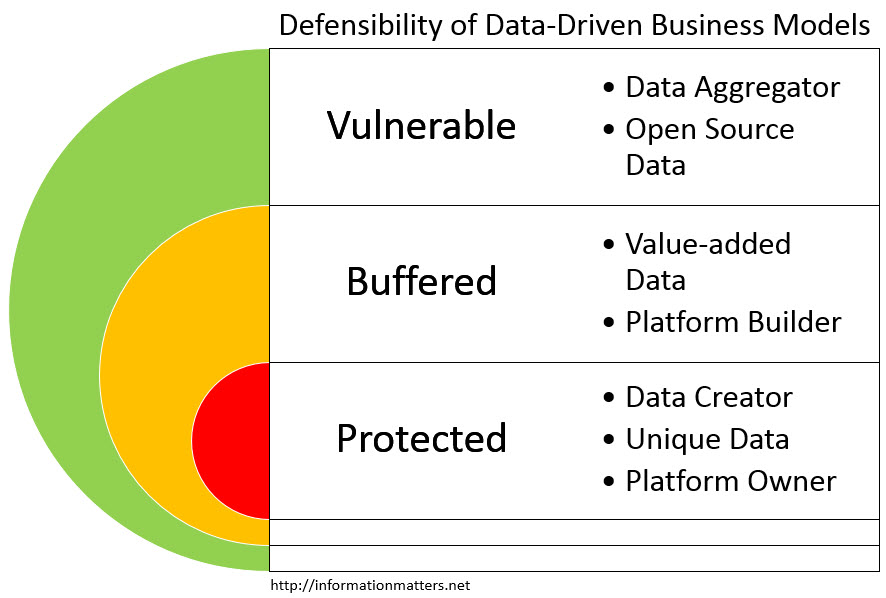I’m in the middle of a research project looking into how startups in the UK and US are building businesses which have data at the heart of their business models. There is a lot of talk about how “data is the new oil”[1]The Economist, 2017. The world’s most valuable resource is no longer oil, but data. The Economist. [online] 6 May. Available at: … Continue reading but there is still a lot of work to be done in understanding how to build a profitable and commercially sustainable business from the processing of data. Recently, researchers at Oxford[2]Bulger, M., Taylor, G. and Schroeder, R., 2014. Data-driven business models: challenges and opportunities of big data. [online] Oxford Internet Institute. Available at: … Continue reading and Cambridge[3]Hartmann, P.M., Hartmann, P.M., Zaki, M., Zaki, M., Feldmann, N., Feldmann, N., Neely, A. and Neely, A., 2016. Capturing value from big data–a taxonomy of data-driven business models used by … Continue reading universities looked at the business models of a range of data-intensive companies and identified a number of different approaches. The need to build on this research has been given impetus by the recent UK government’s Industrial Strategy White Paper[4]Department for Business, Energy & Industrial Strategy, 2017. Industrial Strategy: building a Britain fit for the future. which has set the aim of putting “the UK at the forefront of the artificial intelligence and data revolution”.
One of the issues facing any data-driven startup which seems in particular need of further research is how to defend your business model from competitors. My initial thoughts on this based on some preliminary research has identified the following as tactics which successful data-driven companies have deployed over the last 20 years:
- Lock-in. Finding a way that makes it difficult for customers to migrate to another supplier. Obviously, this needs to be done in a transparent way which does not rely on trickery to keep customers. Until number portability was made compulsory for mobile operators in a number of countries there was an incentive for users to stay with their provider. Moving to a new provider meant receiving a new number which created friction for users who then had to let all their contacts know the number had changed. Retail banking has profitably exploited this friction with customer accounts and the implications that switching banks has for direct debits and standing orders, although this is changing in the UK with new rules. For business models based around the commercialization of data, this has been done through the use of proprietary data formats and the exploitation of network effects. Although you are free to leave Facebook at any time, you cannot take your data with you in a format which can be used by a competing service and the centrality of Facebook connections to the utility of the service means that, even if you could do this, there would be little point as your friends will not be moving with you.
- Unique Data. Owning the data and making it very difficult or even impossible for others to replicate it, is a powerful defense. Internet of Things (IoT) network builders and operators have opportunities in this respect. Controlling the data which comes out of the IoT devices can build a highly-defensible business, particularly where the cost of building a competitive network becomes prohibitive once the system reaches a certain scale.
- Data as by-product. Collecting data can be expensive but if the data is a by-product of another process then the economics can shift dramatically. Social media firms know this as the content on their networks is generated for free by users which then attracts other users, all of whom are sold as eyeballs to advertisers. I’ve been looking at a number of firms offering free services to consumers and then creating commercial data products from that activity which are then sold to other businesses. I’ll write more about this soon.
- Platform building. Everybody wants a platform but building a successful, multi-sided platform is difficult. However, when done successfully it can be a major barrier to entry for new competitors.
The above are just a few observations and will be added to and developed over the coming months and illustrated with examples of companies adopting different strategies in their business models. The figure below summarizes my thoughts so far.

References
| ↑1 | The Economist, 2017. The world’s most valuable resource is no longer oil, but data. The Economist. [online] 6 May. Available at: <https://www.economist.com/news/leaders/21721656-data-economy-demands-new-approach-antitrust-rules-worlds-most-valuable-resource> |
|---|---|
| ↑2 | Bulger, M., Taylor, G. and Schroeder, R., 2014. Data-driven business models: challenges and opportunities of big data. [online] Oxford Internet Institute. Available at: <https://www.oii.ox.ac.uk/archive/downloads/publications/nemode_business_models_for_bigdata_2014_oxford.pdf> |
| ↑3 | Hartmann, P.M., Hartmann, P.M., Zaki, M., Zaki, M., Feldmann, N., Feldmann, N., Neely, A. and Neely, A., 2016. Capturing value from big data–a taxonomy of data-driven business models used by start-up firms. International Journal of Operations & Production Management, 36(10), pp.1382–1406. |
| ↑4 | Department for Business, Energy & Industrial Strategy, 2017. Industrial Strategy: building a Britain fit for the future. |
